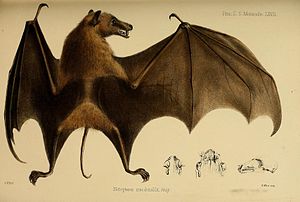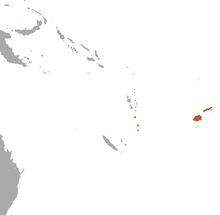Long-tailed bat
| Long-tailed bat | ||||||||||||
|---|---|---|---|---|---|---|---|---|---|---|---|---|

Long-tailed bat ( Notopteris macdonaldi ) |
||||||||||||
| Systematics | ||||||||||||
|
||||||||||||
| Scientific name | ||||||||||||
| Notopteris macdonaldi | ||||||||||||
| Gray , 1859 |
The long-tailed fruit bat ( Notopteris macdonaldi ) is a mammal in the family of flying foxes (Pteropodidae), which in Melanesien occurs. The species epithet in the scientific name honors Dr. Sir John Denis Macdonald . He was the leader of the expedition that caught the specimen for the first description ( holotype ).
features
The species reaches a head-torso length of 93 to 110 mm and a forearm length of 57 to 71 mm. The German name refers to the 43 to 62 mm long tail, which is noticeably long for a flying fox. Two different studies found a weight of 70 to 73 g or an average of 61 g for males. Females weighed 56 to 64 g or around 51 g. The fur is olive brown to dark brown in color, and there are no tufts of hair on the shoulders.
Like the other long-tongue fruit bat (Macroglossini), this fruit bat has a long tongue with papillae. Another characteristic is the lack of a claw on the thumb.
distribution and habitat
The long-tailed bat is found in the island states of Fiji and Vanuatu . The population on Tonga died out shortly after the islands were settled by the Polynesians . The genus includes another species, Notopteris neocaledonica , which lives on New Caledonia . This was counted as a subspecies of the long-tailed batwing until the late 20th century.
Various forests and gardens serve as habitats . In the mountains, moist forests are preferred.
Way of life
The individuals rest in caves and form large colonies there . You can stay in cave areas that have almost no light. Even so, they only use their eyesight for orientation. A study from 1982 registered no ultrasound signals and was able to prove that the navigation was independent of the echo of the emitted sounds.
The long-tailed bat eats nectar , pollen, and fruit juice.
One young is born per litter that is already quite well developed. It clings to the fur on the mother's stomach for the first few days and later remains alone in the cave when the mother is looking for food. In contrast to previous descriptions, there are nurseries in which females and young animals live separately from the males.
Danger
The fruit bat is hunted as a meat supplier in at least one cave in Fiji. Furthermore, disturbances from vandals, tourist visitors or guano collectors have a negative effect on the population. Although the species is protected by law, the population continues to decline. The International Union for Conservation of Nature (IUCN) lists the long-tailed bat as endangered ( Vulnerable ).
Individual evidence
- ↑ a b Don E. Wilson , DeeAnn M. Reeder (Ed.): Mammal Species of the World . A taxonomic and geographic Reference . 3. Edition. 2 volumes. Johns Hopkins University Press, Baltimore MD 2005, ISBN 0-8018-8221-4 (English, Notopteris macdonaldi ).
- ^ Macdonald , The Eponym Dictionary of Mammals
- ↑ a b c d Ronald M. Nowak: Walker's Mammals of the World. Volume 1. 6th edition. 1999, pp. 304-305, ISBN 0-8018-5789-9 .
- ^ A b Nelson & Hamilton-Smith (1982) Some Observations on Notopteris macdonaldi , Australian Mammal Society
- ↑ a b c d e Notopteris macdonaldi in the IUCN Red List of Threatened Species 2014.3. Posted by: Palmeirim, J., 2008. Retrieved May 25, 2015.
